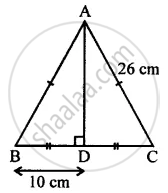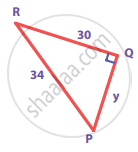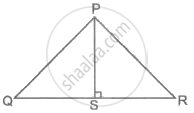Advertisements
Advertisements
Question
Prove that the sum of the squares of the sides of a rhombus is equal to the sum of the squares of its diagonals
Solution

In ΔAOB, ΔBOC, ΔCOD, ΔAOD,
Applying Pythagoras theorem, we obtain
AB2 = AO2 + OB2 ....(1)
BC2 = BO2 + OC2 ....(2)
CD2 = CO2 + OD2 ....(3)
AD2 = AO2 + OD2 ....(4)
Adding all these equation we obtain
AB2 + BC2 + CD2 + AD2 = 2(AO2 + OB2 + OC2 + OD2)
`= 2(((AC)/2)^2 + ((BD)/2)^2 + ((AC)/2)^2 + ((BC)/2)^2)`
(Diagonals bisect each other)
`= 2((AC)^2/2 + (BD)^2/2)`
`= (AC)^2 + (BD)^2`
RELATED QUESTIONS
A ladder leaning against a wall makes an angle of 60° with the horizontal. If the foot of the ladder is 2.5 m away from the wall, find the length of the ladder
ABC is an isosceles triangle with AC = BC. If AB2 = 2AC2, prove that ABC is a right triangle.
Identify, with reason, if the following is a Pythagorean triplet.
(3, 5, 4)
Find the length diagonal of a rectangle whose length is 35 cm and breadth is 12 cm.
Find the value of (sin2 33 + sin2 57°)
The sides of a certain triangle is given below. Find, which of them is right-triangle
6 m, 9 m, and 13 m
In the given figure, angle ADB = 90°, AC = AB = 26 cm and BD = DC. If the length of AD = 24 cm; find the length of BC.

From the given figure, find the length of hypotenuse AC and the perimeter of ∆ABC.
Find the unknown side in the following triangles
In an equilateral triangle PQR, prove that PS2 = 3(QS)2.

